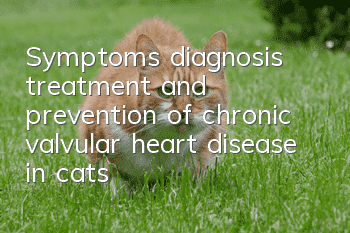Symptoms, diagnosis, treatment and prevention of chronic valvular heart disease in cats

Valvular heart disease (VHD) is a disease caused by damage and thickening of the heart valves in cats. In order to understand the effects of this disease, we must first understand the anatomy of the cat's heart.
A cat's heart is a pump with four chambers and composed of muscles, just like the human heart. The function of the heart valve is to keep blood flowing in the right direction. Under normal circumstances, blood flows first to the atrium, the pump-activating device. The atria then contract, pumping blood into the ventricles, which act like pumps. Only when the blood flow maintains this direction can the heart function as a normal pump. However, once you suffer from valvular heart disease, the valves between the atria and ventricles will undergo degenerative changes, causing the valves to become thicker and deformed. As a result, when the valve closes, the edges cannot seal completely, and a small amount of blood leaks from the ventricle into the atrium with each heartbeat. To compensate for the atretic valve, the heart must pump out more blood with each beat, causing the heart to gradually enlarge. This extra workload causes the heart to weaken and become unable to maintain the body's demands for blood flow. When the heart cannot supply the blood the body needs, this phenomenon is called congestive heart failure.
Symptoms
Unfortunately, in the early stages of heart disease, your cat's body may make adjustments that allow it to adapt to the disease. At this stage, cats may not show obvious symptoms.
As time passes and the condition continues to progress, you may notice the following symptoms:
Cough
Difficulty breathing
Tired after moderate exercise
Faint
Pale gums
Loss of appetite
Diagnosis and Treatment
Your veterinarian will perform a very detailed physical examination, including auscultation of your pet's heart, and may also recommend the following tests to help diagnose your cat's condition.
X-ray examination
Blood test for a cardiac biomarker "N-terminal pro-B-type natriuretic hormone" (NTproBNP)
Biochemical testing and hematology testing (CBC) to assess your pet’s overall health
Blood pressure detection
Electrocardiogram, recording the potential activity of the pet’s heart
Cardiac Ultrasound
If your cat is diagnosed with valvular heart disease, your veterinarian may recommend the following treatments:
Nutritional treatment, such as a low-sodium diet
Use diuretics to remove excess fluid from the body
Daily routineBut controlled movement
If the condition is more serious, medication will also be used
Prevention
Unfortunately, valvular heart disease is a progressive disease that cannot be prevented. But having your cat checked regularly by your veterinarian can help detect heart problems such as valvular heart disease early.
- How to prevent the disease in cats with folded ears
- At what age can a cat be bathed? Cats over three months old can be bathed
- Why does the cat hiccup?
- How do new and old cats get along? How two cats get along harmoniously!
- Why did the cat vomit yellow water?
- What causes pyoderma in cats
- What will happen if a cat eats ants?
- How long will it take for Lan Bai to recognize his master?
- Can stray cats eat egg whites and yolks?
- How to treat skin diseases in kittens? Analyze several common skin diseases



